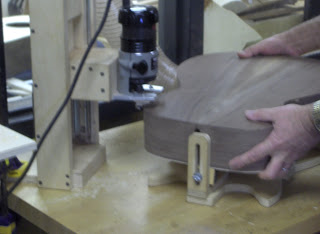Next David used this jig to route dovetail fittings into our neck blocks.


Later I will fit my neck to sit in the slot.

Next I voiced my back much like the top. But instead of notching the sides by hand I used a jig that was set up, with the other jigs I have used, to route the perfect size notches.


Now the back fits just like the top and is glued up in the same fashion.


While this glued up I didn't have much else to do so I squared up the neck black for my guitar. This block makes 2 necks.

I traced out my template and cut a rough shape.

I unclamped the back of the guitar.

It's time to glue in binding on the edges of the guitar. Binding serves many purposes... It hides the braces that go through the ribs, it can protect the guitar if it is dropped, and it, along with purfling, can make the guitar very attractive. Binding is usually made of plastic or wood. I am using plain, cream colored, plastic binding and no purfling because it is quicker and easier and I am on a time limit.

First I route a slot in the sides of my guitar for the binding to sit. I want the binding to sit at a near perfect 90 degrees to the top. So I place the guitar in this sled that holds it at such an angle.


Then I use this laminate trimmer to route into the sides of the guitar. It has a bearing on it that routes the perfect depth and it sits on this jig that holds it to the top of the guitar


Next I am going to route a slot for my end graft. End grafts can get very complicated and beautiful but once again I am going very simple because I am on a schedule. First I use this router jig to make the slot.

It clamps on the top of the guitar and then rests on the table.

and between my legs as I route.

The result is a straight slot just the right size for a piece of my binding.

Next I used a vinyl glue to glue the plastic binding onto the guitar. Because it isn't a wood glue, I put a sealer coat in the slot and let it soak in for 15 min before gluing the binding in. I put the binding in gluing small sections at a time and pressing them in with strapping tape to put pressure vertically and horizontally.


Once that is done I put 3 cam clamps to hold down the ends of the binding.

Once that is dried I carefully remove the tape and fit some binding into the end graft slot.


But instead of strapping tape I used a caul and 3 cam clamps.

Returning after the weekend, I got to see how my binding and end-graft turned out and they turned out pretty darn good I think.

Next step is to scrape down the binding.

And sand the ribs flush with the binding. I also used a flat block to sand a flat spot for the neck to sit against... this is important for setting the neck.


Next I am going to start working on the neck... first I am going to cut the block to the right angle for my neck extension height. This is the height off the top, at the bridge location, of the straight edge resting on the neck, down the centerline. Here I'm resting a straight edge so I can find the precise angle that is needed.

Then I used the bevel to cut the angle into the heel of the neck.

Then I re-checked that it worked, hold the neck on the top and checking with the straight edge.

Next I drew a centerline and drilled a 1/8" hole in the center.

I use the hole to attach the neck to the dove tail jig.

Here David routes the dovetail.



Now the dovetail fits in the neck block.

Next I shape my heel. First I use the spindle sander to get the exact shape of the heel.

Then I use a template to draw the shape of the heel.


Next I use my saw to cut off a majority of the excess.


Then I use my chisels, rasps, and sandpaper to shape the heel.

I sand it out to 220 grit... and I will not touch it again until the final sanding.

The problem now is that it doesn't fit perfectly....

The next step is Setting the Neck.
First you undercut the heel so that the dovetail doesn't bottom out.

Then you used chalk to mark out what is touching and what needs to be shaved off.


You use chisels and sandpaper to take off as much or as little as is needed.


The goal is to get the neck angle correct, centerline even, and the fit tight by shaving the heel.

and have no twist and the neck match up flush by shaving the dovetail.

